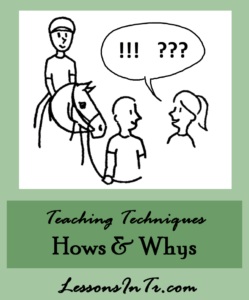Here’s some more notes on teaching techniques that I’ve given ITs (Instructor in Training). This one is focused on using lots of “hows” and “whys” to help your riders learn!
Hows & Whys
Whenever you tell a rider what to do, you need to also tell them how to do it, and why they should do or learn it. Because if you don’t, you just sound like a traffic cop telling them where to go, instead of teaching!
The most common times to use hows and whys are:
- During the first explanation of a new riding skill. (About Teaching the Skill here, and about What/How/Why/Where of the skill here)
- Throughout the rest of the lesson as you give feedback, to reinforce learning and motivation.
- When planning your lesson, in particular preparing to teach the riding skill.
- In your Certification teaching test! In your everyday lessons you will not be constantly talking, but at your certification you want to show the evaluators you know what you are talking about, which means you need to talk a lot even if the riders already know the information and it’s repetitive. A good way to show them this is to include a lot of hows and whys!
Typically you start off with telling them what to do:
- “What” is the skill, instruction, or feedback (praise/correction)
- Ex) “Turn right at A”
- Many new instructors end here, but every “what” should be followed by a “how” and preferably a “why”
How
- A specific detailed description, usually telling them what to do with their body
- You might add “By…” and then finish the sentence.
- Ex) “by bringing your right hand to your right pocket”
- You may need to request sidewalker physical assistance
- Ex) “if you forget, Anna will remind you after a few seconds”
- It depends on the rider’s comprehension and ability how detailed or simple to make your hows.
Why
- The reason/benefit/motivation for them to do this. Why we are telling them this.
- You might add “Because…” or “So that…” or “It helps your horse…” then finish the sentence.
- Ex) “so the horse knows where to go” or “because putting your hand anywhere else tells him something different and confuses him” or “so you can come into the middle for a tack check”
- Ex) “So your horse understands” and “So you don’t hurt your horse” are good motivators
Keep it Simple
Keep your hows and whys simple and to the rider’s level. Use a specific what followed by a short why. Most riders, with or without special needs, only hear the first few sentences from the instructor, then you lose them.
Ex) “Keep your heels down, it helps you have better balance” or “Shorten your reins so you will have better control of your horse.”
There are some riders that can handle a more detailed explanation of “why”, but for the most part a simple explanation is enough. As riders advance, you can add more detail.
Tips:
- Don’t be afraid to use lots of hows and whys! We may feel like we are saying the same thing all the time, but remember your rider is with you only once a week for a little bit of time, with little opportunity to practice between lessons, so the repetition is usually helpful for them. Also, many riders with disabilities need the repetition because of their disability (they may not hear it every time, they may have a hard time remembering, they may have a hard time processing a lot at once, etc.).
- As your riders become accomplished at certain skills, you may be able to drop the hows and whys as they understand them, and only instruct them when to do it. Ex) “Turn right at A.” This is a good way to check whether your rider really know how to do something or not.
- To use more hows and whys in your lesson, whenever you say anything end it with “because…” and finish the sentence.
- Instructors In Training can ask their mentor to stand near them while teaching and say “why?” or “how?” after everything they say (or when they forget to include it).
- Ask the rider themselves for the why. Ex) “Why is it important to keep your eyes up and looking ahead?” This brings them into the conversation, limits the auditory processing from you, and shows you if they understand.
- Show them physically the why. This especially helps kinesthetic learners. Ex) When explaining correct leg posture, move their leg forward and backward to see what it does to their balance.
- Also use your whys after praises, to let the rider know what they have done is correct and why it’s important! Ex) “Susie, you did a nice job shortening your reins before you trotted and that gave you good control of your horse.”
- Use this handout to practice: “PATH Intl’s What, Why and How Method” Handout
Hope that’s helpful!
p.s. Can you tell baby hasn’t come yet because of all the posting I’m doing?
****************
Note: This is not professional advice, this is a blog. I am not liable for what you do with or how you use this information. The activities explained in this blog may not be fit for every rider, riding instructor, or riding center depending on their current condition and resources. Use your best personal judgement! If you would like to contribute an activity or article, please contact me here, I would love to hear from you!

Thanks again for more wonderful help… baby keeping you waiting is our gain!! xxxxx